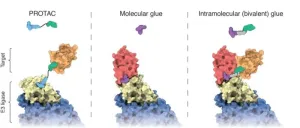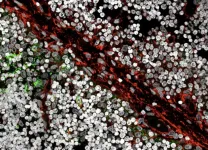(Press-News.org) SARS-CoV-2 triggers the production of the antiviral protein IFN-γ, which is associated with fatigue, muscle ache and depression. New research shows that in Long COVID patients, IFN-y production persists until symptoms improve, highlighting a potential biomarker and a target for therapies.
A University of Cambridge-led study identifies the protein interferon gamma (IFN-γ) as a potential biomarker for Long COVID fatigue and highlights an immunological mechanism underlying the disease, which could pave the way for the development of much needed therapies, and provide a head start in the event of a future coronavirus pandemic.
The study, published today in Science Advances, followed a group of patients with Long COVID fatigue for over 2.5 years, to understand why some recovered and others did not.
Long COVID continues to affect millions of people globally and is placing a major burden on health services. An estimated 1.9 million people in the UK alone (2.9% of the population) were experiencing self-reported Long COVID as of March 2023, according to the ONS. Fatigue remains by far the most common and debilitating symptom and patients are still waiting for an effective treatment.
The study shows that initial infection with SARS-CoV-2 triggers production of the antiviral protein IFN-γ, which is a normal reaction from the immune system. For most people, when their infection clears, COVID-19 symptoms cease and production of this protein stops, but the researchers found that high levels of IFN-γ persisted in some Long COVID patients for up to 31 months.
“We have found a potential mechanism underlying Long COVID which could represent a biomarker – that is, a tell-tale signature of the condition. We hope that this could help to pave the way to develop therapies and give some patients a firm diagnosis,” said co-author, Dr Benjamin Krishna, from the Cambridge Institute of Therapeutic Immunology & Infectious Disease (CITIID).
The research began in 2020 when Dr Nyarie Sithole set up a Long COVID clinic in Cambridge’s Addenbrooke’s Hospital, where he started collecting blood samples from patients and set about studying their immunology. Sithole soon enlisted the support of Dr Benjamin Krishna and Dr Mark Wills from the University of Cambridge’s Dept. of Medicine.
“When the clinic started, a lot of people didn't even believe Long COVID was real,” Dr Sithole said. “We are indebted to all the patients who volunteered for this study, without whose support and participation we would obviously not have accomplished this study”.
The team studied 111 COVID-confirmed patients admitted to Addenbrooke’s Hospital CUH, Royal Papworth Hospital and Cambridge and Peterborough NHS Foundation Trusts at 28 days, 90 days and 180 days following symptom onset. Between August 2020 and July 2021, they recruited 55 Long COVID patients – all experiencing severe symptoms at least 5 months after acute COVID-19 – attending the Long COVID clinic at Addenbrooke’s.
The researchers analysed blood samples for signs of cytokines, small proteins crucial to the functioning of immune system cells and blood cells. They found that the white blood cells of individuals infected with SARS-CoV-2 produced IFN-γ, a pro inflammatory molecule, and that this persisted in Long COVID patients.
Dr Krishna said: “Interferon gamma can be used to treat viral infections such as hepatitis C but it causes symptoms including fatigue, fever, headache, aching muscles and depression. These symptoms are all too familiar to Long COVID patients. For us, that was another smoking gun.”
By conducting ‘cell depletion assays’, the team managed to identify the precise cell types responsible for producing IFN-γ. They pinpointed immune cells known as CD8+ T cells but found that they required contact with another immune cell type: CD14+ monocytes.
Previous studies have identified IFN-γ signatures using different approaches and cohorts, but this study’s focus on fatigue revealed a much stronger influence. Also, while previous studies have noticed IFN-y levels rising, they have not followed patients long enough to observe when they might drop back down.
The Cambridge team followed its Long COVID cohort for up to 31 months post-infection. During this follow up period, over 60% of patients experienced resolution of some, if not all, of their symptoms which coincided with a drop in IFN- γ.
Vaccination helping Long COVID patients
The team measured IFN-γ release in Long COVID patients before and after vaccination and found a significant decrease in IFN-γ post vaccination in patients whose symptoms resolved.
“If SARS-CoV-2 continues to persist in people with Long COVID, triggering an IFN-γ response, then vaccination may be helping to clear this. But we still need to find effective therapies,” Dr Krishna said.
“The number of people with Long COVID is gradually falling, and vaccination seems to be playing a significant role in that. But new cases are still cropping up, and then there is the big question of what happens when the next coronavirus pandemic comes along. We could face another wave of Long COVID. Understanding what causes Long COVID now could give us a crucial head start.”
Microclotting
Some well-publicised previous studies have proposed microclotting as a principle cause of Long COVID.
While not ruling out a role of some kind, these new findings suggest that microclotting cannot be the only or the most significant cause.
Classifying long COVID
This study argues that the presence of IFN-γ could be used to classify Long COVID into subtypes which could be used to personalise treatment.
“It’s unlikely that all the different Long COVID symptoms are caused by the same thing. We need to differentiate between people and tailor treatments. Some patients are slowly recovering and there are those who are stuck in a cycle of fatigue for years on end. We need to know why,” Dr Krishna said.
Reference
B. A. Krishna et al., ‘Spontaneous, persistent, T-cell dependent IFN-γ release in patients who progress to long COVID’, Science Advances (2024). DOI: 10.1126/sciadv.adi9379
END
Long COVID linked to persistently high levels of inflammatory protein: a potential biomarker and target for treatments
2024-02-21
ELSE PRESS RELEASES FROM THIS DATE:
Snaking toward a universal antivenom
2024-02-21
LA JOLLA, CA—Scripps Research scientists have developed an antibody that can block the effects of lethal toxins in the venoms of a wide variety of snakes found throughout Africa, Asia and Australia.
The antibody, which protected mice from the normally deadly venom of snakes including black mambas and king cobras, is described on February 21, 2024, in Science Translational Medicine. The new research used forms of the toxins produced in the laboratory to screen billions of different human antibodies and identify one that can block the toxins’ activity. It represents a large step toward a universal ...
New system triggers cellular waste disposal
2024-02-21
Living cells resemble highly organized small towns - in addition to energy production, transportation systems, and construction, cells also require efficient waste disposal. Most proteins, which shape and sustain cellular function, have only a limited half-life and must eventually be disposed of, along with defective and unwanted proteins. This vital task falls upon specialized enzymes known as ubiquitin ligases, which tag obsolete proteins for degradation, guiding them to the cellular recycling center, ...
Possible trigger for autoimmune diseases discovered : B cells teach T cells which targets must not be attacked
2024-02-21
Immune cells must learn not to attack the body itself. A team of researchers from the Technical University of Munich (TUM) and the Ludwig Maximilian University of Munich (LMU) has discovered a previously unknown mechanism behind this: other immune cells, the B cells, contribute to the "training" of the T cells in the thymus gland. If this process fails, autoimmune diseases can develop. The study confirms this for Neuromyelitis optica, a disease similar to Multiple Sclerosis. Other autoimmune diseases may be linked to the failure ...
Detecting pathogens faster and more accurately by melting DNA
2024-02-21
A new analysis method can detect pathogens in blood samples faster and more accurately than blood cultures, which are the current state of the art for infection diagnosis. The new method, called digital DNA melting analysis, can produce results in under six hours, whereas culture typically requires 15 hours to several days, depending on the pathogen.
Not only is this method faster than blood cultures, it’s also significantly less likely to generate false positives compared to other emerging DNA detection-based technologies such as Next Generation Sequencing.
Why ...
MD Anderson research highlights for February 21, 2024
2024-02-21
HOUSTON ― The University of Texas MD Anderson Cancer Center’s Research Highlights showcases the latest breakthroughs in cancer care, research and prevention. These advances are made possible through seamless collaboration between MD Anderson’s world-leading clinicians and scientists, bringing discoveries from the lab to the clinic and back.
Recent developments at MD Anderson offer insights into drug-drug interactions for patients with acute myeloid leukemia (AML) and myelodysplastic syndromes; patient-derived xenograft models as a viable translational ...
Engineers use AI to wrangle fusion power for the grid
2024-02-21
In the blink of an eye, the unruly, superheated plasma that drives a fusion reaction can lose its stability and escape the strong magnetic fields confining it within the donut-shaped fusion reactor. These getaways frequently spell the end of the reaction, posing a core challenge to developing fusion as a non-polluting, virtually limitless energy source.
But a Princeton-led team composed of engineers, physicists, and data scientists from the University and the Princeton Plasma Physics Laboratory (PPPL) have harnessed ...
UChicago scientists invent ultra-thin, minimally-invasive pacemaker controlled by light
2024-02-21
Sometimes our bodies need a boost. Millions of Americans rely on pacemakers—small devices that regulate the electrical impulses of the heart in order to keep it beating smoothly. But to reduce complications, researchers would like to make these devices even smaller and less intrusive.
A team of researchers with the University of Chicago has developed a wireless device, powered by light, that can be implanted to regulate cardiovascular or neural activity in the body. The featherlight membranes, ...
Accelerometer-measured physical activity, sedentary time, and heart failure risk in older women
2024-02-21
About The Study: The results of this study of 5,951 women ages 63 to 99 suggest that promoting regular physical activity and minimal sedentary time may be prudent for primary prevention of heart failure and its subtype with preserved ejection fraction for which treatment is limited.
Authors: Michael J. LaMonte, Ph.D., M.P.H., of the University at Buffalo—SUNY, is the corresponding author.
To access the embargoed study: Visit our For The Media website at this link https://media.jamanetwork.com/
(doi:10.1001/jamacardio.2023.5692)
Editor’s Note: Please see the article for additional information, including other ...
Lifetime suicide attempts in otherwise psychiatrically healthy individuals
2024-02-21
About The Study: In this study using data from 1,948 U.S. adults with lifetime suicide attempts from a nationally representative population-based survey, an estimated 19.6% reported not having met criteria for any psychiatric disorders prior to their first attempt. This finding challenges clinical notions of who is at risk for suicidal behavior and raises questions about the safety of limiting suicide risk screening to psychiatric populations.
Authors: Maria A. Oquendo, M.D., Ph.D., of the University of Pennsylvania in Philadelphia, is the corresponding author.
To access the embargoed study: Visit our For The Media ...
Acupuncture for combat-related posttraumatic stress disorder
2024-02-21
About The Study: The acupuncture intervention used in this randomized clinical trial including 93 participants was clinically efficacious and favorably affected the psychobiology of posttraumatic stress disorder (PTSD) in combat veterans. These data build on extant literature and suggest that clinical implementation of acupuncture for PTSD, along with further research about comparative efficacy, durability, and mechanisms of effects, is warranted.
Authors: Michael Hollifield, M.D., of the Tibor Rubin VA Medical Center in Long Beach, California, is the corresponding author.
To access the embargoed study: Visit our For The Media website at this link https://media.jamanetwork.com/
(10.1001/jamapsychiatry.2023.5651)
Editor’s ...




